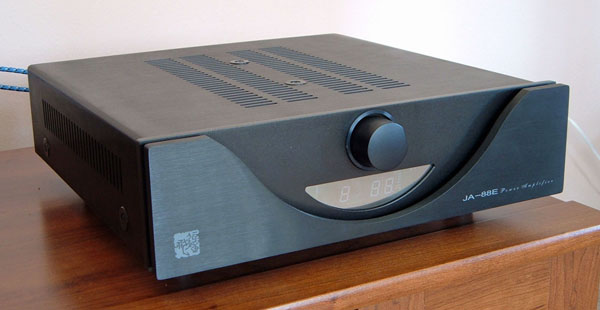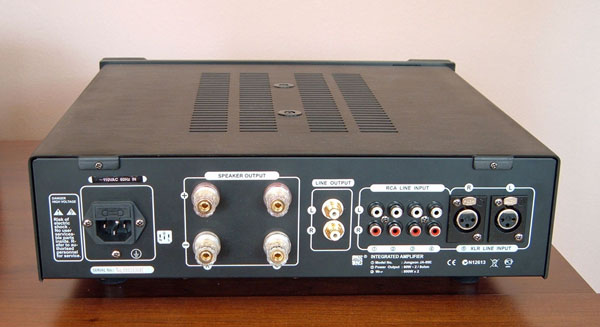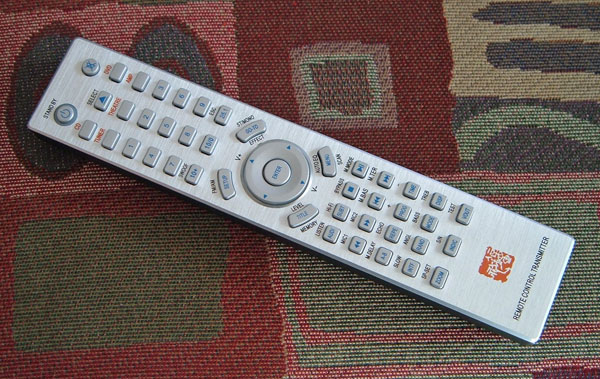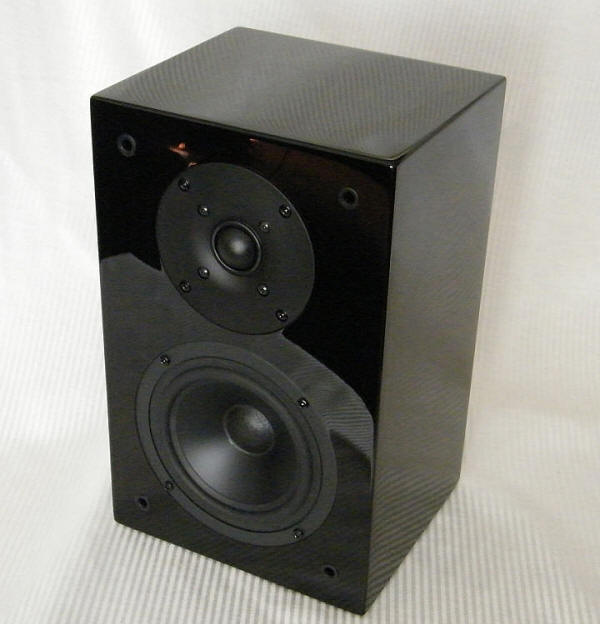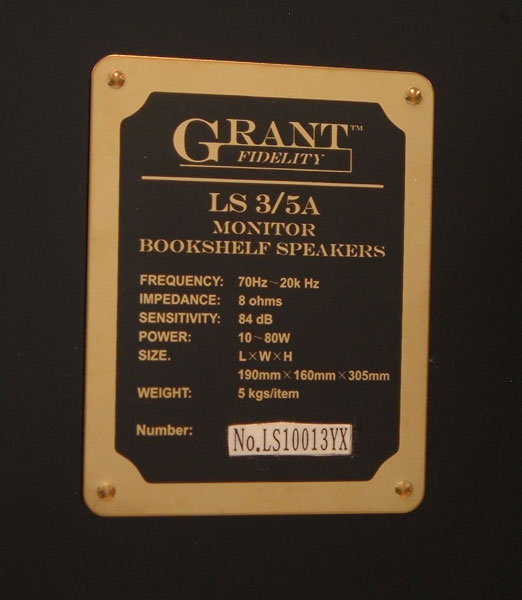|
You are reading the older HTML site Positive Feedback ISSUE 47january/february 2010
The
Jungson JA-88E Integrated Amplifier and the Grant
Fidelity LS3/5A Loudspeakers - a Systems Approach
Grant Fidelity offers these components as the relatively inexpensive core of a seriously musical system. Assuming that the purchaser already has a source component, this amp and speakers, along with GF's cabling, can be producing music for just over $2000. It's difficult to find very many new component systems that start this reasonably. I have listened to this amp and speakers in both of my systems, as individual components, and as a system. Here is what I can tell you about them. The Jungson JA-88E ($800)
There are some American Express commercials currently running in which various inanimate objects appear as faces. I guess it is our innate anthropomorphous tendency to see faces in the things around us that makes this commercial so interesting. (It would be more interesting if the photos did not change so quickly.) If the Jungson JA-88E were to appear in these commercials, it would clearly be as a Cyclops. A very minimal, but smiling Cyclops. The front fascia of the Jungson consists of a volume knob centrally located over a hemispherical display panel. These are part of an 8mm thick aluminum plate which has a second 9mm thick plate attached to its front. The outermost plate has a semi-circular cutout that clears the JA-88E's display and volume control. As far as styling goes, that's it. The rest of the Jungson is a substantial black metal box with slots for heat dispersion and inputs/outputs on the rear. The fit and finish of the amplifier is very good, as we have come to expect from Chinese-made audio products. The stepped-attenuator volume knob is the only control on the amplifier other than an On/Off switch (which is located on the bottom panel at the right front). There are neither tone controls nor balance control. There is no phono section. The display window indicates the input being used—either 5 for the single balanced input, or 1-4 for the single-ended RCA inputs. My listening was all done single-ended. The volume readout ranges from 0 to 99. I did my listening in my living room system with my Quad 21L2 speakers between 9 and 13. With the Grant Fidelity LS3/5As in my main system, the volume level varied from about 19 to 22.
The rear panel has an IEC AC cord connection, good quality speaker binding posts, the already mentioned inputs, and a line output. Interestingly, the line output uses better quality RCA jacks than the inputs themselves.
The JA-88E is supplied with a universal remote. This remote has 45 buttons on it of which 5 are actually used with this amplifier. Unfortunately, it did not control my Sony SACD player as well, which would have been very convenient. Once the "Amp" button is chosen as the source component, the remaining controls are Select for the inputs, Mute, Volume Up and Down, and Display. The display of the Jungson toggles between really bright, bright, and off. I found it somewhat distracting so I tended to listen with it off. This did not make any difference in the sound quality that I could detect. You may have noted that it is not possible to turn the unit on or off using the remote. That has to be done at the unit or via the power conditioner, which is what I did. The JA-88E is rated at 80 WPC into an 8 Ohm load. Listening to the JA-88E The Jungson amp was installed in my second system and was used there for a couple of months. I listened to all sorts of music through it and it never failed to be enjoyable to listen to. It was dead silent through the speakers; the only noise it makes is a clicking when the volume level is changed. In the course of listening, I found the Jungson to have a slightly muted quality in its treble performance. While the treble does not sound rolled off in terms of frequency response, its highs do sound slightly reduced in level. This wasn't so obvious that it interfered with enjoying the music itself but could be detected on many familiar recordings once I became aware of it. Midrange information came through the Jungson in very good shape. The bass is quite good as demonstrated by numerous tracks of the New Moon soundtrack (Summit Ent/Chop Shop/Atlantic 519421-2). All of the tracks on this CD are very interesting to listen to and many of them also showed off the very good soundstaging of the JA-88E. Soundstage width was very good with this amp, while soundstage depth was average to good, depending upon the recording. Given the JA-88E's price range and the equipment that it will likely be paired with, Jungson has voiced this amplifier very sensibly. With inexpensive speakers and CD players it will emphasize their strengths while downplaying their weaknesses. Used as an integrated amp in my second system, the Jungson's scorecard ended up reading: Treble: Slightly muted but clean Midrange: Very Good Bass: Very good Soundstage: Very good width, average depth Low Level Detail: Good Despite parsing the JA-88E's performance into categories, my notes also remarked on how well "the music dominates the sound." This seems like a good place to note that the JA-88E ran remarkably cool. I could not feel any warmth over the heat sinks even after hours of running it. I was not sure if this was typical as the manual states that this amplifier "produces relatively large amounts of heat in operation." I checked with Ian Grant about this and he stated that Jungson makes Class A amps that use the same chassis, hence the warning and the ventilation. The JA-88E runs in Class AB, one of the few Jungson amps that do not run in Class A. At the same time, I found the Jungson needed about half an hour of warm-up after turn-on to sound its best. Continuing As I mentioned, the JA-88E has one set of line level outputs. These would typically be used for a subwoofer but they also allow for pairing the preamp section with a different power amplifier. I tried this using my veteran VTL 50-50 tube amp. As a preamp, the JA-88E lost the subtly muted treble quality that it had exhibited with its own amplifier. The treble was more forward, subjectively louder, and better balanced with the midrange and bass. There was also a perceptible increase in detail and the system sounded more immediate. Handel's Violin Sonatas played by Andrew Manze (Harmonia Mundi HMX 2907259) now clearly demonstrated the somewhat sharper tonal range of the baroque violin. It never became shrill but it sounded more like the real thing than it had through the JA-88E's power section. The very nicely reverberant harpsichord sounded more open as it supported the violin. Hints of Vivaldi and Handel's own "Fireworks" could be heard more clearly within these compositions. Chris Botti's trumpet playing "My Funny Valentine" on Legends of Jazz (LRS Media 968700) had a realistic edge. The air pressure needed to start each note was tangible as well, a detail that was not as well defined with the JA-88E's amplifier. Each track on this CD comes from a different recording venue and those differences could be easily heard. The New Moon soundtrack gained clarity, intelligibility, and, on some tracks, the edginess that was intended to be there. Likke Li's "Possibility" filled the space between the speakers while her somewhat wispy vocals floated above them. "Friends" by Band of Skulls offered a powerful midbass and very catchy refrain. Really deep bass was provided by the bass drum on OK Go's "Shooting the Moon." According to my daughter, the New Moon movie is pretty marginal unless you are female and under fifteen. (Not that it stopped her from seeing it. Can a male actor make it in the movies today while wearing a shirt?) The soundtrack, however, is full of interesting music. The improvements that were evident in soundstage depth, immediacy, and low-level detail with the VTL in the system imply to me that the detail is there in the JA-88E's preamp section but is being curtailed somewhat by the amplifier section. Referring back to my earlier scorecard, I would easily give the JA-88E a Very Good for every category noted when used as a preamplifier. At this point, the Jungson went downstairs to my main system for further evaluation. Grant Fidelity LS3/5A loudspeakers ($980 a pair)
These GF speakers are one of four that I was able to find currently being sold as LS3/5As. The other three are from Rogers, which sell for $1995 per pair; Stirling Broadcast, which also sell for $1995 per pair; and Gini Systems, which sell for $520 per pair as a kit and $590 assembled. There are certainly dozens more speakers out there that are LS3/5A derivatives, clones, copies, and even upgrades. They just aren't labeled as LS3/5As. This proliferation prompted me to do some research to determine just what it is that qualifies a loudspeaker as an actual LS3/5A. In the early 1970s, the British Broadcasting Company needed a small near-field monitor for use in its remote broadcasting trucks. There were no commercial speakers available that met their standards for accuracy and consistency, so they built their own speaker, the LS3/5A. It was intended to be built so consistently, unit to unit, that any two LS3/5A speakers could be chosen at random by a recording engineer for monitoring use and they would match each other within extremely small tolerances. Taken a step further, in theory, any licensed BBC LS3/5A from any of the companies building them could be mated with a speaker from any other company and be as well matched. To make this possible, KEF made all of the drive units and crossovers both for themselves and other manufacturers. Original examples licensed by the BBC and built by Rogers, Audiomaster, RAM, Goodmans, KEF, Chartwell, Spendor, and Harbeth can still be found in the used market. Rogers alone is estimated to have manufactured 43,000 pairs of the roughly 60,000 LS3/5As manufactured The original 1972 LS3/5A used a 19mm KEF T27 Mylar tweeter and a 110mm KEF B110 Bextrene bass driver doped with Plastiflex in a sealed cabinet. The speaker had an impedance of 15 Ohms and a thirteen element crossover that allowed fine tuning for minor differences in the drivers themselves. A rectangular felt "fence" enclosed the tweeter to minimize diffraction effects; the grill cloth was made of a fabric called "Tigon" and designed to be left on all the time. The woofer was mounted to the rear of the front baffle. The sealed five-liter cabinet was also a significant part of the design. The LS3/5A cabinet was made of veneered 12mm plywood with the back attached by screws. Corner braces were of beech and the interior was lined with bituminous padding. Amplifier connection was via a single pair of binding posts. The finished speaker had a high frequency response that extended to 40KHz and a low frequency resonance of around 75Hz. This resulted in a -6dB low frequency extension of about 60Hz—certainly decent performance from a 4.5 inch mid-woofer designed for free-standing placement away from bass-reinforcing walls or corners. Efficiency, however, suffered as the speaker is rated at 81.5-82 dB at 1Watt/1 meter¹. According to Martin Colloms², the original speaker was voiced octave by octave for lifelike naturalness with flat frequency response never an objective. In fact, flat frequency response versions of the LS3/5A have actually been built. Two of these are the KEF Reference 101 and Linn Kan, neither of which was considered as musical or natural-sounding as the original non-flat version, although each had its own strengths. In the 1980s a new KEF bass driver was designed to deal with the inconsistencies of the B110. This resulted in an 11 Ohm version of the speaker, the result of a simpler crossover. This made the speaker somewhat less colored and "nasal" than the original but lacking in the original version's bass punch. Some reviewers have liked it better than the original and some have not. Recently, Rogers has re-introduced their version of the LS3/5A after a several year hiatus. Ken Kessler has compared it to his original 1970s Rogers speakers and says that it is the real item³. Of course, the new Rogers speaker, as well as the Grant Fidelity, uses different drivers than the originals. KEF quit making the drivers around 2000. Due to the lack of original KEF drivers, it is obvious that no current LS3/5A can be truly the same as the original in anything but sound quality. Looking at the Grant Fidelity speaker, it is immediately obvious that there is no felt fence around the tweeter and that the woofer is mounted to the front of the baffle, not the rear. The cabinet, which measures 12 by 7.5 by 6.5 inches, has a seven-layer black piano finish over a composition core. It is also capable of being bi-wired via good quality binding posts. Bi-wiring was acceptable to the BBC as long as the speaker sounded like the original version in single-wire mode. The GF speaker is also almost twice as efficient as an original LS3/5A at 84dB for 1W, 1 meter.
So what can be expected of the Grant Fidelity version of the LS3/5A? Here is what they say about this speaker on their web site. "Emulating the original KEF drivers and crossovers with new drivers from China and faithfully recreating the original cabinet all out of new materials. The result on the Grant Fidelity LS3/5A is the invisible crossover and accuracy of the original, but with a smoother bass response that both studio and home user are going to fall in love with. Closed cabinet but this small sized speaker produces a stunning HUGE soundstage. For the music lover and audiophile, you get a speaker that completely vanishes from the musical performance, leaving you with a 3 dimensional soundstage without the hotspots of speakers. Either in your main listening system or placed in a smaller room, these speakers will sing." Let's see how well. Listening to the LS3/5A My initial listening was done using my reference system—Sony SACD player, Dodd preamp, and Rogue 90 amplifier. I put the LS3/5As on 24-inch speaker stands and placed the stands just inside where my Magneplanar 1.6 speakers are usually positioned. This located the speakers about 7 feet apart. After experimenting with both toe-in and listening position, I ended up with the speakers slightly toed-in and my chair about 8 feet from either speaker. Speaker cables were my bi-wire set of Alpha Core Goertz MI2s and single-wire pair of Supra Sword 3.0s. I used the Supras for most of my listening. The binding post jumpers that come with the GF speakers are very minimal and do not seem to have any sonic effect of their own. I listened with the grills on and off. I felt that there was very slightly more spaciousness with the grills off but the difference was extremely subtle. How good are these Grant Fidelity speakers? My initial reaction to hearing them was to question whether I had disconnected the MG1.6s or had only imaged doing so. The performance was amazing. The soundstage was huge, placing the piano accompanying Jane Monheit two feet outside of the right speaker. Her voice was not only realistic but there was a concrete sense of her presence in the room itself. Cymbals shimmered from the depths of the soundstage and the acoustic bass sounded, well, like an acoustic bass. The ability of such a small speaker to reproduce bass so realistically with both impact and depth truly stunned me. And that was just the first track of Best Audiophile Voices (Premium PR 27831). The rest of the tracks were equally enthralling. Alison Krauss' voice had all of the airy ethereal quality that I expect from it. Eva Cassidy, Karrin Allyson, and the rest of the female singers on this disc sounded as good as I have heard them. Backing instruments, whether piano, guitar, drums, or especially acoustic bass had realistic size and were located solidly in the soundstage. I had the feeling that I was experiencing cognitive dissonance firsthand. My brain could not relate the size and weight of what I was hearing with the size and weight of the speaker producing it. This feeling did not change while listening to Time Further Out, Dave Brubeck's follow-up recording to the legendary Time Out. Here again, the soundstage extended well outside of the speakers. The drum solo on Track 5, "Far More Drums," was as dynamic, deep, and fast as the recording allowed. The hand claps on Track 7, "Unsquare Dance," were absolutely realistic and solidly anchored within the soundstage. Paul Desmond's sax had the airy, spitty sound of the real thing. In its own way, this recording is as innovative as the original Time Out. The Grant Fidelity LS3/5As had no trouble keeping up with the rapid-fire guitar playing on The Very Best of Acoustic Alchemy (GP 314 589 238-2) or reproducing the large, fully packed but artificial soundstage surrounding them. The bass is not terribly deep on this recording but getting its speed right is important. The GF speakers had no problem in doing this. Frankly, I expected the LS3/5As to do well very with midrange and treble information and I was correct. The real question was how well would they do bass given both their diminutive size and sealed box alignment? The Monterey Quartet: Live at the 2007 Monterey Jazz Festival (MJR-31244) answered this question extremely well. Track 2, "Minotaur" has a drum solo that shows the GF speakers' dynamic and bass capabilities. The drum hits are not hinted at or suggested, as might be expected from a small speaker, they are impressively reproduced. I was at this point in the review when I had some friends over to hear my reference system. We listened to a lot of different music and tried some of Paul Kaplan's excellent but expensive AC cords. The group was equally interested in hearing the LS3/5As. We used M•A Records wonderful J. S. Bach: 6 Suites a Violincello, Vol. 1, (M•A M073A) as one of the recordings. The small GF speakers reproduced the full range of the cello with remarkable fidelity. If there was anything missing, it wasn't in any way evident. I feel very comfortable saying that everyone was very impressed with these speakers. Several of the listeners felt that they gave up virtually nothing to the MG1.6s we had been using. And everyone came away amazed by their low-end performance. These are experienced audiophiles/listeners who have good systems. To be as impressed as they were by the GF speakers reinforced my own favorable opinions regarding their performance. I wanted to do one more thing—listen to some large orchestral music—before pairing the LS3/5As up with the JA-88E. For this I chose Rainbow Body, a collection of short orchestral pieces played by the Atlanta Symphony Orchestra (Telarc CD-80596). This CD includes "Rainbow Body" by Christopher Theofanidis, Samuel Barber's "Symphony No. 1," "Appalachian Spring," and "Blue Cathedral" by Jennifer Higdon. All of these selections sounded wonderful through the GF LS3/5As. The Barber symphony probably gave them the biggest workout, however, moving from soft to very loud and requiring the speakers (and the system) to sustain lengthy loud passages played by the bass violins and tympani. They did this with surprising ease. I am sure that their reproduction of the lowest frequencies and loudest passages was somewhat curtailed but there was never any outright evidence of that happening. There was no sense of strain or compression limiting the reproduction of the music. Soundstaging was excellent with all of these compositions but "Blue Cathedral" was spectacular. There almost no sense of the speakers having any connection whatsoever to the music being played. I have heard excellent soundstaging in my listening room but nothing that bettered this. Just in case I am not making myself clear here, all the strengths that the Grant Fidelity LS3/5As exhibited with smaller scale works were just as evident with these full symphonic compositions. The ability to maintain individual instrumental lines, the ability to go from loud to soft and back again, and the ability to convey an actual visceral sense of being in the room with the music were remarkable. As a System When I finally listened to these two components together, I heard a sound that was pretty much what I expected based upon the listening that I had done separately. "Blue Cathedral" was nearly as magical as it had been with my reference electronics. There was, however, a subtle lack of air around the instruments and a comparably subtle lack of detail. Offsetting this was noticeably better depth within the soundstage than I had heard with the JA-88E in my living room system. Voices, such as Madeleine Peyroux's on her Dreamland CD (Atlantic 82946-2) lacked just the final bit of richness that I heard from the LS3/5As with my reference electronics. This same CD exhibited a very good sense of scale with the JA-88E, however. On track 6, "Always a Use," the voice and guitar were reproduced virtually life-sized in my room. Jacintha's Here's to Ben (Groove Note GRV 1001) was beautifully reproduced by the Jungson/GF combination. Subtle breathing sounds and reverberations were preserved by these components providing a very real sense of her being present in the room. If any criticism could be leveled at the sound being produced, it was only the knowledge that it can be reproduced slightly better with far more expensive equipment. Summary I was pretty hard on both of these components while I had them. I listened to them with my reference cables and system and made no allowance for their prices while evaluating them. Both the speaker cables and interconnects used cost more than either of these components. Under these terms, there was very little to criticize. Allowing for their actual prices, there is much less. While the Jungson JA-88E and Grant Fidelity LS3/5As can be combined as the core of a quality audio system, they are not equals in terms of their capabilities. I would not hesitate to recommend the Jungson JA-88E to anyone looking for an under $1000 integrated amplifier. While there is a subtle muting of the treble, there is nothing else about its performance to pick on. I feel pretty confident that anyone hearing it in my system playing Jacintha would estimate its price at two to three times what it actually costs. The fact that it can be used as a preamp adds, I think, significantly to its value and brings a concomitant increase in performance as well. Buy it as an amp now; use it as a preamp later. The performance of the Grant Fidelity LS3/5As is on another level entirely. They have impressive dynamics and frequency range, especially as regards their bass performance. Their soundstaging is as good as it gets. There is also an honest and direct quality about them that leaves you feeling that you have heard the music, not the speakers. These speakers cannot be judged by their price—it's utterly irrelevant—they can only be judged by their performance, which is exceptional in every respect. For listeners looking for a speaker of this type and size, I think the GF LS3/5A will end their search. I can see the Jungson amp being purchased as an entry level component and then upgraded over time but not these speakers. I think they will be used from the day they are purchased until they wear out. They are wonderful; they are an incredible buy; and they will make you glad you own them every time you use them. So, are these truly LS3/5As? I wish I had a pair of BBC LS3/5As with which to compare them but I don't. Based upon what I have read, however, I would have to say, no, these are not true LS3/5As. They are better than that. They truly do sing. 1. My information was compiled from articles in Stereophile, HiFi News, the HiFi Critic, and HiFi Choice magazines. Writers were J. Gordon Holt, John Atkinson, Dick Olsher, Ken Kessler, Martin Colloms, and Alan Sircom. 2. Martin Colloms, HiFi Critic May/June 2007. 3. Ken Kessler, HiFi News, May 2008 An excellent web site for LS3/5A aficionados is www.ls35a.com
Grant Fidelity
|

